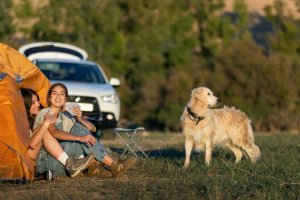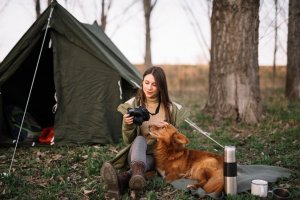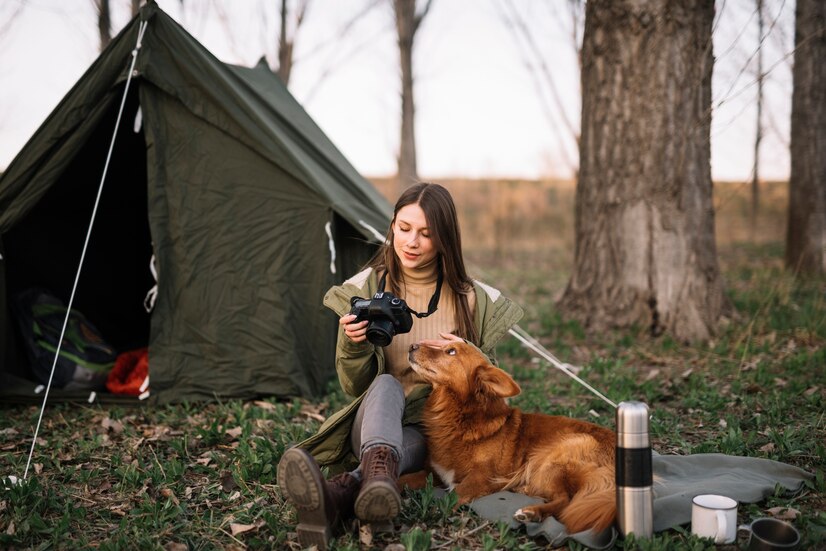
Charmaine Miller shares her tips to ensure a great camping trip with your dog.
If you already consider yourself an outdoorsy person, nothing beats the adventure of going camping. But your next camping experience may be even more forgettable if you make plans to bring your dog along. The sights, sounds, and scent of fresh air will be a delight to both of you as long as you’re adequately prepared.
While it may seem appealing to go on a spontaneous camping trip with your dog, remember that you’ll need to do twice the prep and make extra considerations for your dog. As their owner, it’s also your responsibility to keep your dog safe as well as ensure that they’re having fun, and to train them to behave considerately in front of other campers.
Below are six essential tips for planning the ultimate camping getaway with your pooch:
1) Check the Campsite’s Rules and Regulations
Before embarking on your adventure, confirming whether your prospective campsite welcomes furry friends. Campsite regulations regarding dogs can vary widely, as some sites warmly welcome pets while others have strict no-pet policies. The site may also have specific leash laws, designated dog-friendly areas, or even breed restrictions.
Do your research beforehand to guarantee that you’re compliant with your intended campsite’s rules, and ultimately choose a location where you and your dog won’t be short-changed in your experience.
2) Ensure That Your Dog’s Healthy and Has Up-to-Date Vaccinations
Much like humans need to make sure that they’re in the pink of health before leaving for any kind of trip, the same goes for dogs. Different regions may have varying pet health risks, such as tick-borne diseases or specific allergens in the air. It’s wise to schedule a vet visit before you go camping with your dog to confirm that all their vaccinations are current and to discuss any potential health concerns based on your camping destination.
For instance, your vet might recommend a preventive tick treatment if you’re heading to a wooded area. Having this knowledge on hand will allow you to pay close attention to your dog’s well-being and enjoy a little more peace of mind with regard to the flora and fauna you’ll encounter.

3) Make a Checklist of Your Dog’s Essentials for a Hassle-Free Trip
Careful preparation can make all the difference between a smooth camping trip and one that you won’t want to repeat. Perhaps before you start packing for yourself—arguably the easier task—make a checklist of your dog’s essentials, like their collars, harnesses, custom collapsible travel cups, and daily medications.
Consider the duration of your trip and pack an adequate amount of food, plus a bit extra, in case of any unforeseen delays. Don’t forget to include a supply of fresh water, especially if you’re uncertain about the purity of the natural water sources at your destination.
Lastly, always pack waste bags for you and your dog and practice the “Leave No Trace” principle. It keeps the environment clean and sets a positive example for other campers.
4) Engineer a Comfortable Sleeping Arrangement for Your Dog
Camping might offer an escape from our daily comforts, but neither you nor your canine companion should spend the night shivering on the cold ground or battling pesky bugs. Invest in a good-quality insulated dog sleeping pad, or bring along an old blanket, to help your dog sleep more comfortably.
Also look into the weather conditions at your campsite. If it’s forecasted to be a bit chilly, you can bring a dog sleeping bag or a specialized tent to provide your pooch with extra warmth.
Ultimately, just as you’d want a cozy and protected spot to rest after a long day of outdoor activities, your dog deserves a good spot to recharge. A well-rested dog is a happy camper!

5) Mind Your Dog’s Training and Behavior for the Outdoors
The unpredictable nature of the outdoors means that you can sometimes get into situations that test your dog’s discipline. Your pet might be the star pupil at the local dog park, but they’ll find plenty of cool distractions in the great outdoors. Prioritize mastering essential commands like “stay,” “come,” and especially “leave it” when your dog shows interest in unknown plants, discarded food, or wildlife.
For example, a squirrel darting up a tree could be an extremely exhilarating sight for your dog, but could lead to trouble. Review their training before and during the trip so that they remain respectful of their surroundings.
6) Follow Trail Etiquette When Hiking
If you’re planning to go on short hikes during your camping trip, be extra conscientious about following basic trail etiquette. Keep your dog on a leash and ensure they don’t stray off the trail so that you can protect the local flora and prevent potentially dangerous encounters with wildlife.
When you’re approaching or being approached by another hiker, especially if they have their own dogs, communicate and give space or pull over to the side. Allow them to pass while keeping your dog calm and close to you. Such practices will ensure that every camper and hiker on the trail, both two-footed and four-footed, will enjoy their time in nature without unnecessary disturbances.
Final Thoughts on a Camping Trip with Your Dog
Camping with your dog is sure to be an enriching experience, but it’s also one that requires proper planning. Being well-prepared means you can focus on what’s most important—making lasting memories with your canine companion in the outdoor environment you love so much.

Your thoughts?
Have you gone on a camping trip with your dog? How did it go? Please share your experiences below together with any tips you would add.

Charmaine Miller
Charmaine Miller is a life-long pet lover and animal rights advocate. She works as a pet sitter and dog walker by day and volunteers at a local animal shelter by night. In her spare time, she loves to bake, write, and sing to her favorite Beyonce songs.














Leave a Reply